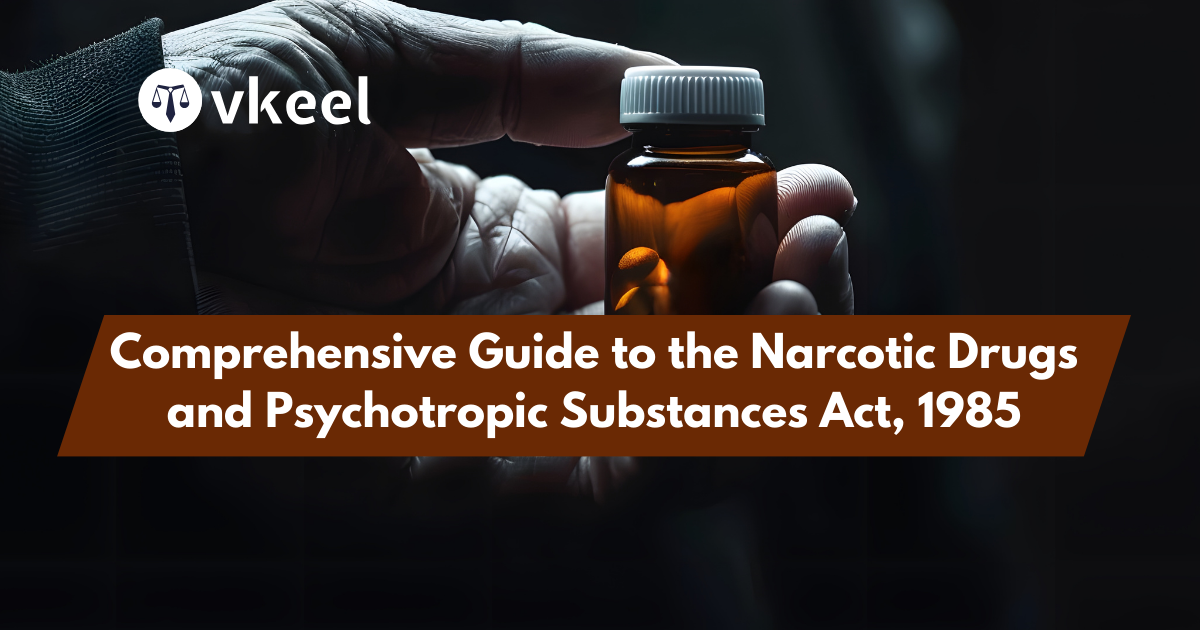Comprehensive Guide to the Narcotic Drugs and Psychotropic Substances Act, 1985
By Himanshu Kumar
Table of Contents
Introduction
The Narcotic Drugs and Psychotropic Substances Act, 1985 (NDPS Act), is a crucial piece of legislation in India aimed at combating drug abuse and illicit trafficking. Enacted to fulfill India’s obligations under various international conventions, the NDPS Act seeks to regulate the operations related to narcotic drugs and psychotropic substances.
The primary objective of the Narcotic Drugs and Psychotropic Substances Act, 1985 (NDPS Act), is to combat and eradicate the menace of drug abuse and illicit trafficking in India. Enacted in response to growing national and international concerns, the Act seeks to consolidate and amend laws relating to narcotic drugs and psychotropic substances, ensuring stringent regulations and penalties for offenders. By criminalizing various activities associated with narcotic drugs and psychotropic substances, such as production, manufacture, possession, sale, purchase, transport, warehousing, use, consumption, import, and export, the NDPS Act aims to dismantle the networks of illicit drug trade and reduce the prevalence of drug abuse in society. The Act also aligns with India’s obligations under international conventions, reinforcing the country’s commitment to global drug control initiatives.
Another significant objective of the NDPS Act is to strike a balance between controlling drug abuse and providing a legal framework for the medical and scientific use of narcotic drugs and psychotropic substances. The Act recognizes the necessity of these substances in healthcare and research, thus permitting their regulated use for legitimate purposes. Additionally, the NDPS Act emphasizes the rehabilitation and treatment of drug addicts, recognizing addiction as a health issue rather than solely a criminal offense. This approach underscores the Act’s dual focus on law enforcement and public health, aiming to foster a more humane and effective strategy to tackle drug addiction while maintaining stringent measures against illicit activities.
Historical Background
The need for a stringent law to combat drug trafficking and abuse in India arose from the growing menace of drug addiction and the increasing involvement of organized crime in drug trade. Prior to the NDPS Act, India’s approach to drug regulation was governed by various fragmented laws, which proved inadequate in addressing the complexities of drug-related crimes.
In response to these challenges and in alignment with international conventions such as the Single Convention on Narcotic Drugs (1961) and the Convention on Psychotropic Substances (1971), the Indian Parliament enacted the NDPS Act in 1985. This legislation aimed to consolidate and amend existing laws related to narcotic drugs, making the legal framework more robust and comprehensive.
Key Provisions of the NDPS Act
The NDPS Act covers a wide range of activities related to narcotic drugs and psychotropic substances, including cultivation, production, manufacture, possession, sale, purchase, transport, warehousing, use, consumption, import inter-state, export inter-state, import into India, export from India, and transshipment. Some of the salient features of the Act include:
- Definitions (Section 2): The Act provides detailed definitions of various terms such as ‘cannabis’, ‘coca leaf’, ‘cocaine’, ‘opium’, ‘psychotropic substance’, etc.
- Prohibition and Control (Section 8): The Act prohibits the production, manufacture, possession, sale, purchase, transport, warehousing, use, consumption, import inter-state, export inter-state, import into India, export from India, and transshipment of narcotic drugs and psychotropic substances except for medical or scientific purposes in the manner and to the extent provided by the Act.
- Punishments (Sections 15 to 44): The Act prescribes stringent penalties for various offenses. For instance, trafficking offenses can attract rigorous imprisonment ranging from 10 to 20 years along with a fine, depending on the quantity of drugs involved.
- Forfeiture of Property (Chapter V-A): The Act includes provisions for the forfeiture of property derived from or used in illicit trafficking of narcotic drugs and psychotropic substances.
- Procedure and Powers (Chapter V): The Act empowers officers of various ranks to conduct searches, seizures, and arrests without a warrant under specific circumstances. It also lays down procedures for the disposal of seized narcotic drugs and psychotropic substances.
Amendments to the NDPS Act
Since its inception, the NDPS Act has undergone several amendments to address emerging challenges and to fine-tune its provisions for better enforcement. Notable amendments include:
1. The Narcotic Drugs and Psychotropic Substances (Amendment) Act, 1988
This amendment introduced the concept of “controlled delivery,” allowing law enforcement agencies to track and arrest the higher echelons of drug trafficking networks. It also established special courts for speedy trial of offenses under the Act.
2. The NDPS (Amendment) Act, 2001
One of the significant changes introduced by this amendment was the rationalization of punishment based on the quantity of the drug involved – “small quantity” and “commercial quantity” – thus ensuring proportionality in sentencing. It also allowed for bail provisions under certain conditions and introduced a more lenient approach towards addicts who voluntarily seek de-addiction treatment.
3. The NDPS (Amendment) Act, 2014
This amendment made notable changes, including the introduction of Section 31A which prescribes the death penalty for repeat offenders in cases involving significant quantities of drugs. It also allowed for the medical use of cannabis and its derivatives and provided a legal framework for the regulation and licensing of opioid substitution therapy.
Significant Case Laws
1. Mohammad Zahid v. State of Tamil Nadu (1999)
This case emphasized the importance of compliance with procedural safeguards under the NDPS Act, particularly Section 50, which mandates informing the accused of their right to be searched in the presence of a magistrate or a gazetted officer. The Supreme Court held that non-compliance with this provision renders the search illegal and the accused is entitled to acquittal.
2. State of Punjab v. Baldev Singh (1999)
In this landmark judgment, the Supreme Court elaborated on the procedural requirements under Section 50. It ruled that the accused must be informed of their right in a meaningful manner, and a mere formal compliance without explaining the right is not sufficient.
3. Tofan Singh v. State of Tamil Nadu (2020)
This case significantly impacted the interpretation of statements recorded under Section 67 of the NDPS Act. The Supreme Court held that statements made to officers empowered under the NDPS Act are not admissible as evidence unless corroborated by independent evidence, aligning with the constitutional protection against self-incrimination under Article 20(3).
4. Arif Khan @ Agha Khan v. State of Uttarakhand (2018)
In this case, the Supreme Court reiterated the importance of following the procedural requirements of Sections 42 and 50 of the NDPS Act. The failure to comply with these provisions led to the acquittal of the accused, highlighting the necessity for strict adherence to procedural safeguards to ensure fair trials.
Enforcement and Challenges
1. Stringent Enforcement
The NDPS Act is enforced by various agencies, including the Narcotics Control Bureau (NCB), the Directorate of Revenue Intelligence (DRI), and state police departments. These agencies are empowered to conduct raids, seizures, arrests, and prosecutions related to narcotic drugs and psychotropic substances.
2. Challenges in Implementation
Despite its stringent provisions, the NDPS Act faces several implementation challenges:
- Procedural Lapses: Non-compliance with procedural safeguards often results in acquittals, undermining the effectiveness of the Act.
- Overcrowded Prisons: The stringent bail provisions lead to overcrowding of prisons with undertrial prisoners, many of whom are addicts needing rehabilitation rather than incarceration.
- Judicial Delays: Special courts established for speedy trials often face backlog, resulting in prolonged judicial processes.
Rehabilitation and De-addiction
Recognizing drug addiction as a health issue, the NDPS Act includes provisions for the treatment and rehabilitation of addicts. The government has established various de-addiction centers and rehabilitation programs to help individuals recover from addiction. Amendments to the Act have emphasized the need for a compassionate approach towards addicts, promoting voluntary de-addiction and rehabilitation efforts.
Recent Developments
1. Emphasis on Harm Reduction
There is a growing recognition of the need for harm reduction strategies in dealing with drug abuse. The NDPS Act, through its amendments, has started incorporating provisions for the medical use of certain narcotic drugs and the regulation of opioid substitution therapy, reflecting a shift towards a more balanced approach.
2. International Cooperation
India has been actively participating in international efforts to combat drug trafficking. The NDPS Act provides a framework for cooperation with other countries in matters of mutual legal assistance, extradition, and controlled delivery operations.
Conclusion
The Narcotic Drugs and Psychotropic Substances Act, 1985, is a comprehensive piece of legislation aimed at curbing the menace of drug trafficking and abuse in India. Over the years, the Act has undergone significant amendments to address emerging challenges and to enhance its effectiveness. Landmark judgments by the Supreme Court have further shaped the interpretation and implementation of the Act, ensuring procedural fairness and adherence to constitutional protections.
While the NDPS Act has been instrumental in combating drug-related crimes, it also faces several challenges, including procedural lapses, judicial delays, and the need for a balanced approach towards addicts. Recent developments and amendments reflect a shift towards incorporating harm reduction strategies and international cooperation, aiming for a more holistic and effective approach to drug control.
As India continues to battle the complexities of drug trafficking and abuse, the NDPS Act remains a critical tool in the legal framework, striving to protect public health and ensure justice.
Disclaimer:
The information provided in the article is for general informational purposes only, and is not intended to constitute legal advice or to be relied upon as a substitute for legal advice. Furthermore, any information contained in the article is not guaranteed to be current, complete or accurate. If you require legal advice or representation, you should contact an attorney or law firm directly. We are not responsible for any damages resulting from any reliance on the content of this website.







